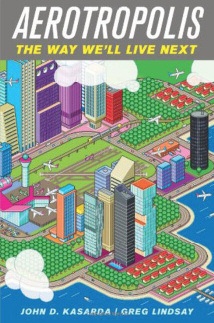A certain beloved urban theorist once wrote about cities and the wealth of nations. With all due respect to Jane Jacobs, forget about nations. In the age of globalization, nations matter less and less. You'd think that cities would too, with the proliferation of electronic communication and the magic of the "cloud." But, argue John D. Kasarda and Greg Lindsay, one of the big reasons why cities will continue to thrive is actually up among the real clouds.
The somewhat unnerving implication of Aerotropolis is that the great cities of the global age aren't so much cities but rather are catchment areas for airports -- specifically, airports that fling people and goods across oceans. We don't think of thriving cities today as "airport cities" the way we think of the great "port cities" of, say, the Industrial Age. But if the connection to a river or an ocean was good for New York, Baltimore, and St. Louis, then surely the connection to Asia, Europe, and even Africa can be good for the cities of today. Kasarda and Lindsay argue, in fact, that the connection is crucial. In fact, it's hard to argue otherwise.
All the efficiencies of globalization still rely on face-to-face contact, and many of them still rely on physical goods. iPods might not rot on a two-week ocean voyage, but they're a heck of a lot more valuable if Apple can flood the stores with them on the day of their release. The Asian city that can send that precious cargo and the American city that can receive it will both reap the benefits.
The best parts of Aerotropolis are those chapters that describe the incredible machinations of globalization as they play out in every corner of the globe. The authors connect the rose plantations of Kenya with the flower markets of Amsterdam. They explain why Dubai is ideally situated to be the Constantinople of the future, with 3 billion of the world's most ambitious people in range of a single hop on a 777. They tell you exactly how your FedEx and UPS orders go from warehouse, to their respective mega-hubs in Memphis and Louisville, to your house.
Some of your houses might actually be in the flight path, for better or worse. The first chapter of Aerotropolis focuses on LAX and Washington DC's Dulles. The former is described as a potentially great airport that, over 70 years, has become hemmed in by a growing city and now hampered by cranky neighbors. The latter was once the middle of nowhere but is now a magnet for corporate offices; the Dulles corridor is one of the biggest "downtowns" in the country. At Dallas-Ft.Worth, the Las Colinas luxury home development caters specifically to bigwigs who need to catch a flight to Frankfurt right now. They reserve choice words for anyone who would stifle international air travel, such as environmetalists opposing a new runway at Heathrow and a dysfunctional Thai government that made a hot mess of Suvarnabhumi.
The glaring problem with Aerotropolis is that the authors never really explain what "an aerotropolis" is supposed to look like. Is it literally a city built up around an airport? It is just an idea, like -creative city'? Should it include certain uses and take certain forms? Is it whatever John Kasarda says it is? And what comes first, the airport or the city?
Aerotropolis answers none of these questions clearly. So it's hard for planners, for instance, to know what to do about their aerotropolitan ambitions. At some moments, they dub every city with an airport economy to be an aerotropolis, in one way or another. At other times, they imply that there is some ideal aerotropolis out there, such as the new city of Songdo in South Korea, that perfectly, seamlessly merges the advantages of urban agglomeration with those of cheap, fast jet travel. Sometimes, it seems as though the aetrotropolis is just an idea that hangs over the formal relationship between airport and city -- especially when dispensing useless pretensiousness such as, "the city is the airport."
The authors praise cities like Dubai and moan about cities like Los Angeles, London, and Bangkok, but ultimately, the only proper aerotropolis seems to be the one that Kasarda himself helped design.
And that's the most maddening part of Aerotropolis. At some times, we're cruising through the terminals of Singapore and Shanghai. At other times, we are confronted with full-on advertisements for the brilliance that is John Kasarda. Unique in the annals of nonfiction, Aerotropolis refers to its own author in the third-person, even going to far as to quote the author himself. Lindsey is the book's actual author and devoted fan of all things Kasarda, while Kasarda himself--a professor of business who has been developing the aerotropolis concept (whatever that is) and advising cities for decades--positions himself as the star of the book, like Richard Florida with Platinum Elite status. Except John Kasarda is no Richard Florida.
Kasarda would be better off presenting his ideas and leaving it at that. They are compelling ideas, made more compelling by the fact that there is no single, ideal way for any city to dominate global commerce. Instead, ham-fisted examples of self-promotion abound-without much real insight for planners who might want to find out how to get on board with the global economy.

Aerotropolis: The Way We'll Live Next
John D. Kasarda & Greg Lindsay
Farrar, Strauss, Giroux
